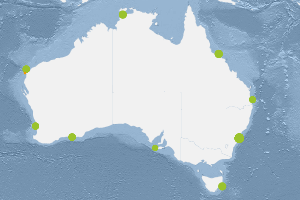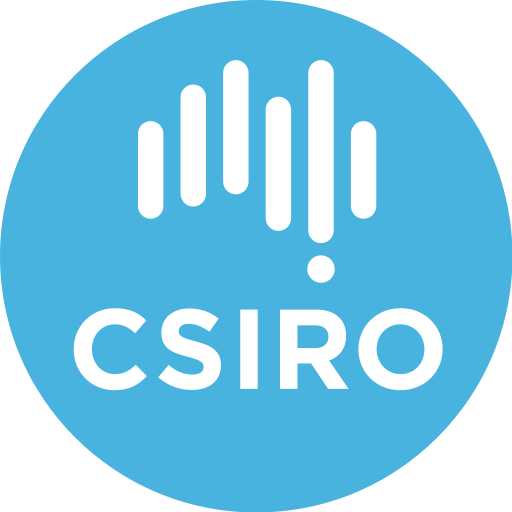Topic
oceans
4152 record(s)
Type of resources
Topics
Keywords
Contact for the resource
Provided by
Years
Formats
Representation types
Update frequencies
Status
draft
-
This record contains data collected from the near-water surface sampling site off the Lucinda Jetty, as part of the Lucinda Jetty Coastal Observatory. Sample collection began the 9th of January, 2014. The data can be used for Ocean Colour sensor validation. Parameters measured include the absorption coefficients of the particulate and dissolved components of the water column and the phytoplankton pigment concentration and composition.
-

This dataset comprises the phytoplankton abundance and biovolume estimates as part of a broader sampling program carried out at the Southern Ocean Time Series, a facility within the Integrated Marine Observing System (IMOS). The primary focus is sustained observing of ocean properties and processes important to climate, carbon cycling, and ocean productivity. Regular phytoplankton samples are collected at approximately 14 day intervals (exact intervals and seasonal coverage dependent on deployment length). The moorings are serviced annually, at which time the existing moorings are recovered and new moorings are deployed. Water samples from within the surface mixed-layer are collected at pre-programmed intervals using a Remote Access Sampler, in pairs about 1 hour apart. One sample in each pair is preserved for phytoplankton community composition by microscopy, and the other sample is preserved and used for accompanying chemical analysis of nutrients, total dissolved inorganic carbon (DIC) and alkalinity. Each sample is collected from within the surface mixed-layer at 32 m depth (2010 - 2017) or 5 m depth (2018-current) depending on the design of the mooring surface assembly and instrumentation. Typically a maximum of 24 samples are collected over an annual deployment cycle. The samples collected are analysed for: 1. Community composition / abundance (cells/L) 2. calculated biovolume (um3/L). Protocols for the phytoplankton time-series are described in Eriksen et al (2018), and the annual sample reports for each deployment. Data storage and access is planned to be interoperable with other national and international programs through the IMOS Infrastructure. Station metadata can be found through this resource. Data is available freely via the AODN portal: https://portal.aodn.org.au. As the taxonomic resolution of the data has changed over time, due to continual training, it is important that users refer to the change log tables included in your data download. These will provide information on the validity of the taxa, from what date we have been identifying certain taxa etc. Classification fields may be blank depending on the level to which that taxa has been identified, i.e. if only identified to family, genus and species will be blank.
-
This dataset shows the global distribution of seagrasses, and is composed of two subsets of point and polygon occurence data. The data were compiled by UNEP World Conservation Monitoring Centre in collaboration with Dr Frederick T. Short (University of New Hampshire, USA).
-
This dataset shows the global distribution of coral reefs in tropical and subtropical regions. It is the most comprehensive global dataset of warm-water coral reefs to date, acting as a foundation baseline map for future, more detailed, work. This dataset was compiled from a number of sources by UNEP World Conservation Monitoring Centre (UNEP-WCMC) and the WorldFish Centre, in collaboration with WRI (World Resources Institute) and TNC (The Nature Conservancy). Data sources include the Millennium Coral Reef Mapping Project (IMaRS-USF and IRD 2005, IMaRS-USF 2005) and the World Atlas of Coral Reefs (Spalding et al. 2001). Purpose IMaRS-USF was funded by the Oceanography Program of NASA (National Aeronautics and Space Administration) to provide an exhaustive worlwide inventory of coral reefs using high-resolution satellite imagery, under the framework of the Millenium Coral Reef Mapping Project. As a fully validated Millennium Coral Reef Mapping Project product was not available at the global scale, there was a need to create an 'interim' global amalgamated map product. The dataset was hence created to further mobilise the Millennium Coral Reef Mapping Project products and their validation.
-
The original World Vector Shoreline (WVS) was a digital data file containing the shorelines, international boundaries, and country names of the world. WVS data were processed into NGA’s Vector Product Format in 1995, resulting in the highest resolution demarcation of coastline globally available, the World Vector Shoreline Plus. Six libraries exist, within this single worldwide database, at scales ranging from 1:250,000 to 1:120,000,000. Each library contains a Countries/Coastlines/Oceans (COC) coverage, including both line and area features such as coastlines, political boundary lines, and other lines of separation, administrative areas, and oceans. Each library also contains the following reference coverages: library reference (LIBREF), which gives an overview of the library; tile reference (TILEREF), which defines the tiling scheme for each library; and names placement (GAZETTE), which contains point features that represent the approximate centroid of each locality in the WVS Plus database. The maritime boundaries (MAB) and maritime boundaries supplemental (MBS) coverages contain maritime claims for each country as derived from the Maritime Claims Reference Manual, DOD 2005.1M, 2001. MAB and MBS are found only in the WVS250K library (1:250,000 scale). The bathymetry (BAT) coverage exists only in the WVS003M, WVS012M, and WVS040M libraries and contains depth contours and depth areas derived from the digital bathymetric database product. See the Vector Product Format (VPF) World Vector Shoreline (WVSPLUS) Draft Specification (MIL-PRF-89012A dated August 24, 1999) for a detailed product definition, and the VPF Military Standard (MIL-STD-2407) for more descriptions of VPF. Tidal Datum: Mean high water (MHW)
-
This dataset shows the global distribution of seagrasses, and is composed of two subsets of point and polygon occurrence data. The data were compiled by UNEP World Conservation Monitoring Centre in collaboration with Dr Frederick T. Short (University of New Hampshire, USA). The boundaries do not represent actual ranges as seagrass are distributed in waters shallow enough for sunlight to penetrate. No surface area calculations should be attempted.
-
Since 1984, the NOAA Fisheries Service's Large Marine Ecosystems (LME) Program has been engaged in the development and implementation of an ecosystem-based approach to support assessment and management of marine resources and habitats. Five linked program modules have been developed for introducing the LME approach: productivity, fish and fisheries, pollution and ecosystem health, socioeconomics, and governance. Taken together, these modules provide time-series measurements used to support actions for the recovery, sustainability, and management of marine resources and habitats. A global effort is underway by NOAA in partnership with the World Conservation Union (IUCN), the UN's Intergovernmental Oceanographic Commission (IOC), and other UN agencies to improve the long-term sustainability of resources and environments of the world's 66 LMEs and linked watersheds. Scientific and technical assistance is provided to developing countries committed to policies and actions for eliminating transboundary environmental and resource-use practices that lead to serious degradation of coastal environments and their linked watersheds, and to losses in biodiversity and food security. LMEs are natural regions of ocean space encompassing coastal waters from river basins and estuaries to the seaward boundary of continental shelves and the outer margins of coastal currents. They are relatively large regions of 200,000 km2 or greater, the natural boundaries of which are based on four ecological criteria: bathymetry, hydrography, productivity, and trophically related populations. The theory, measurement, and modeling relevant to monitoring the changing states of LMEs are imbedded in reports on ecosystems with multiple steady states, and on the pattern formation and spatial diffusion within ecosystems. The concept that critical processes controlling the structure and function of biological communities can best be addressed on a regional basis has been applied to the ocean by using LMEs as the distinct units for marine resources assessment, monitoring, and management.
-
This dataset represents the Longhurst provinces (1998) of the world
-
Undersea feature names The GEBCO Sub-Committee on Undersea Feature Names (SCUFN) maintains and makes available a digital gazetteer of the names, generic feature type and geographic position of features on the sea floor. The gazetteer is available to view and download via a web map application, hosted by the International Hydrographic Organization Data Centre for Digital Bathymetry (IHO DCDB) co-located with the US National Centers for Environmental Information (NCEI). The data are available in a number of formats including spreadsheet, shapefile, KML, WMS and ArcGIS layer and can be accessed as a REST-style API. IHO-IOC GEBCO Gazetteer of Undersea Feature Names, www.gebco.net
-
Two mangrove sites and two seagrass sites were sampled in each region of the Gulf of Carpentaria; Weipa (between 1991 and 1994) and Groote Eylandt (between 1994 and 1995). The stable isotope ratios of seagrass, mangroves and prawns were measured, and the contribution of mangroves and seagrass to prawn food webs was estimated.
